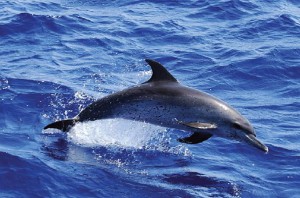
A dolphin frolics in the Tañon Strait. (Oceana)
A novel lawsuit filed by Cebu lawyers on behalf of dolphins, whales and other marine mammals to protect the Tañon Strait seven years ago scored a victory.
The Supreme Court in a unanimous decision yesterday struck down as unconstitutional the service contract granted in 2004 to Japan Petroleum Exploration Co. Ltd. (Japex) for oil exploration and drilling in the Tañon Strait.
The narrow body of water between the islands of Cebu and Negros is the largest protected seascape in the country.
The court, however, also ruled that dolphins and other marine animals have no legal personality to sue.
“Only humans have personality to sue,” said the Supreme Court’s public information office.
The ruling is deemed moot and academic after Japex pulled out of the Tañon Strait in 2008 “for lack of commercial oil and gas deposits” in the area.
Japex conducted the exploratory drilling from late 2007 until early 2008.
Cebu environment advocates strongly opposed it and local fishermen complained that their fish catch declined due to the disturbance in the sea.
Tañon Strait was declared a protected seascape in 1998 by President Fidel V. Ramos through Proclamation No. 1234 to protect its marine resources, including endangered species of dolphins and whales.
In a decision penned by Associate Justice Teresita Leonardo de Castro, the High Court nullified Service Contract 46 (SC-46) because it failed to comply with constitutional safeguards.
The court noted that the contract was signed only by then Energy Secretary Vincent Perez Jr. and not by the President. Neither was the contract submitted to Congress.
The 1987 Constitution requires that a service contract be authorized by a general law, signed by the President, and reported to Congress.
The court also ruled that the contract violated Republic Act Number 7586 or the National Integrated Protected Areas System (NIPAS) Act of 1992. Tañon Strait is considered an environmentally critical area, where exploitation of natural resources is restricted.\
READ: Summit pushes for Tañon Strait plan after 17 years of waiting
Cebu lawyer Gloria Estenzo-Ramos, one of the petitioners, representing the marine mammals, hailed the SC decision as a landmark ruling that would compel government agencies to follow the rule of law.
“I’m happy about the decision, except that the Supreme Court is not yet ready to appreciate the legal standing to sue of the environment. They are still stuck with traditional (parameters),” she said in an interview.
Ramos filed the case with colleagues Benjamin Cabrido and Liza Osorio in 2007.
Ramos is now vice president of Oceana-Philippines, an international NGO dedicated to marine conservation.
Cabrido recalled how people laughed at him for filing suit on behalf of dolphins.
Hammerhead sharks are some of the endangered species found in the Tañon Strait between Cebu and Negros islands. Photo courtesy of OCEANA.
“This victory is not for me but for all those who expressed concern about the welfare of our marine mammals,” he said.
Vince Cinches of Greenpeace , who said the court should consider that nature has a legal right, welcomed the decision: This a good reason to celebrate Earth Day.”
Marine biologist Lemuel Aragones, who added his expert voice in the controversy in 2008, said the drilling affected the surface behavior of the population of cetaceans, which refers to species that include dolphins, porpoises and toothed whales, in the Tañon Strait.
The court case was labeled Resident Marine Mammals of the Protected Seascape Tañon Strait, et al. vs. Secretary Angelo Reyes et. al.
Named respondents were former Energy secretary Angelo Reyes, former Environment secretary Jose Atienza, former Agriculture Secretary Arthur C. Yap, Leonardo Sibbaluca of DENR 7, and Japex, represented by its Philippine agent, Supply Oilfield Services.

